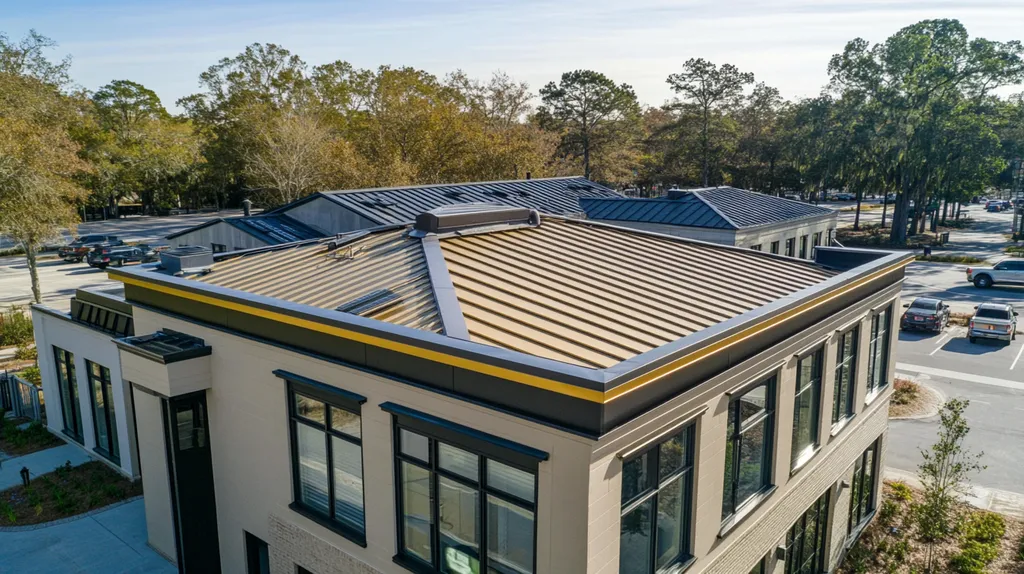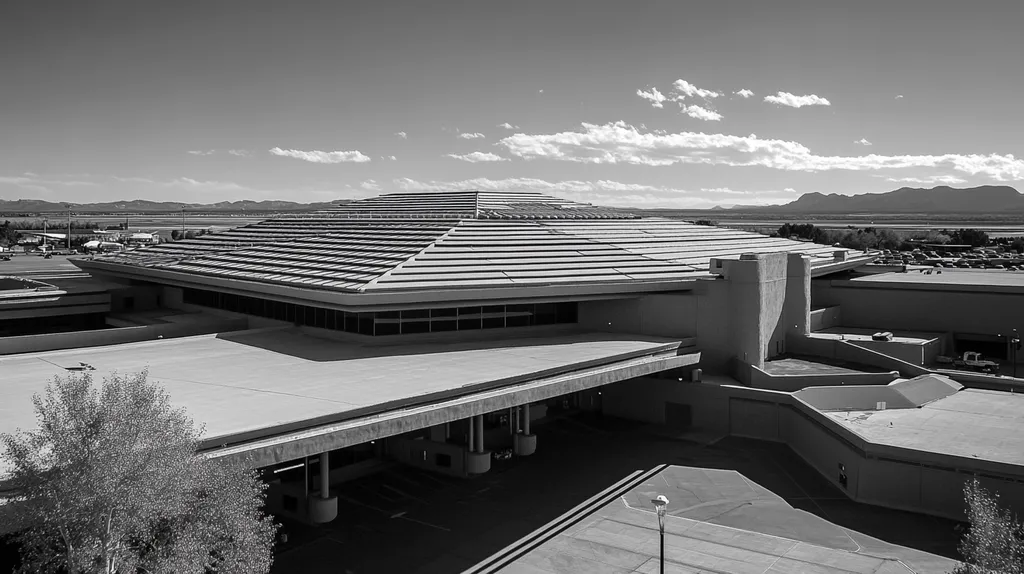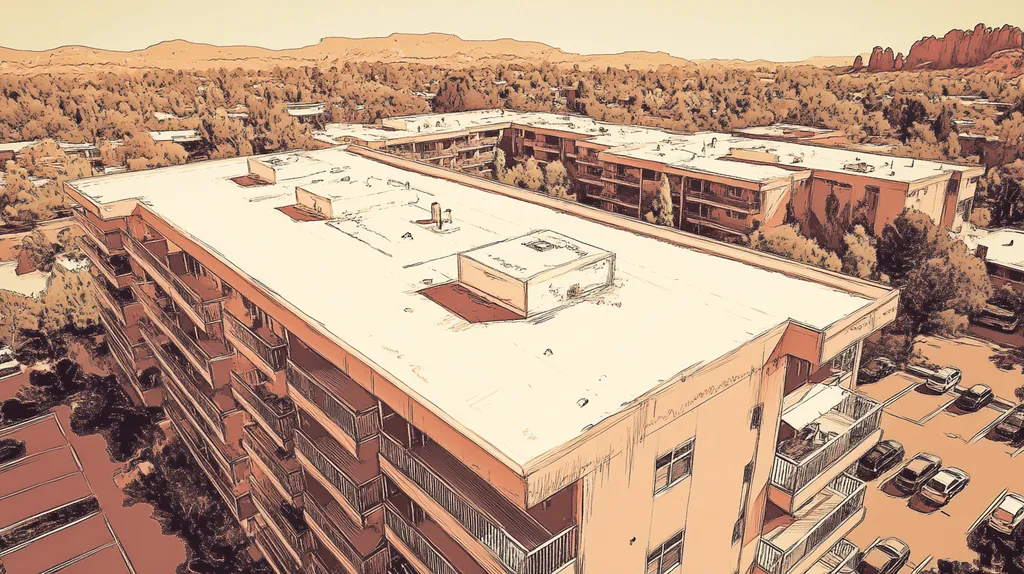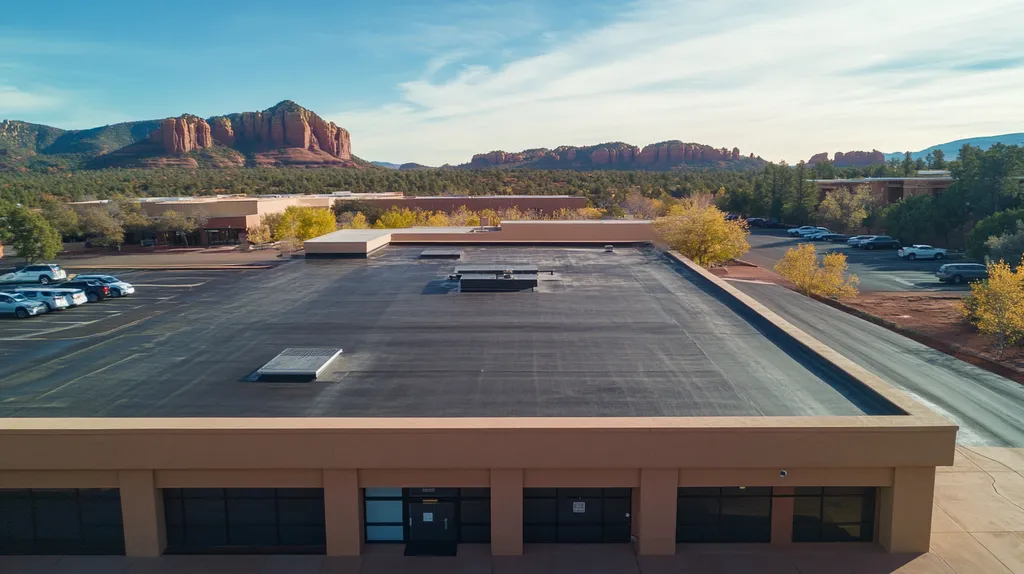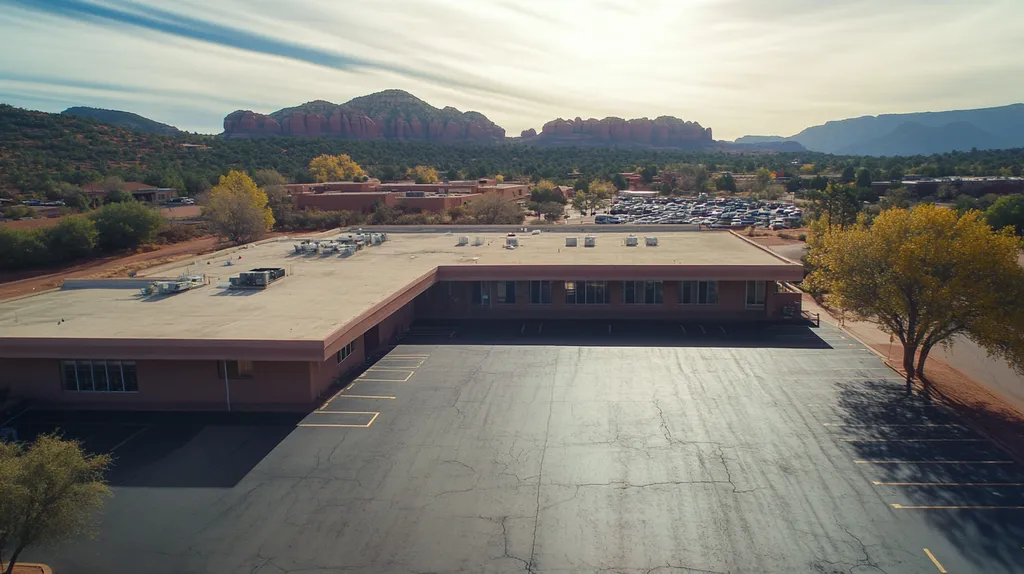Commercial buildings contribute 40% of total energy consumption in the United States, with traditional roofing systems generating millions of tons of landfill waste annually while forcing mechanical systems to work 20-30% harder than necessary.
The shift toward eco-friendly commercial roofing delivers measurable operational benefits beyond environmental responsibility. These systems reduce energy costs by 10-25%, extend roof lifecycles, and meet increasingly stringent building performance standards that drive property values.
Understanding sustainable roofing fundamentals enables facility managers to navigate material options, installation requirements, and performance trade-offs. Strategic implementation transforms roofs from passive barriers into active building performance assets that generate long-term value.
SECTION 1: THE BASICS EXPLAINED
Commercial buildings consume 40% of total energy in the United States, with roofing systems playing a critical role in this consumption pattern. Traditional roofing approaches generate substantial waste streams, create urban heat islands, and force mechanical systems to work harder than necessary.
The shift toward eco-friendly roofing represents more than environmental responsibility—it delivers measurable operational benefits. Understanding these systems enables facility managers to reduce energy costs, extend roof lifecycles, and meet increasingly stringent building performance standards.
What It Is (In Plain Language)
Eco-friendly roofing encompasses materials and systems designed to minimize environmental impact throughout their entire lifecycle. These solutions focus on three core principles: resource conservation, energy efficiency, and waste reduction.
Cool roofs utilize reflective surfaces to deflect solar radiation, while green roofs incorporate living vegetation to provide natural insulation and stormwater management. Solar-integrated systems transform roof surfaces into energy-generating assets.
Metal roofing, often recycled, reflects sunlight to keep buildings cool and lowers air-conditioning needs. Clay tiles provide energy efficiency through air circulation and are low maintenance. (source: Cedur)
The common thread among these options is their ability to reduce operational costs while delivering superior environmental performance. They represent a fundamental shift from viewing roofs as passive barriers to active building performance systems.
Why It Matters (To Your Building)
Energy costs represent the largest controllable expense for most commercial properties, and roofing systems directly influence these costs. Reflective roofing can reduce cooling loads by 10-15%, translating to thousands of dollars in annual savings for large facilities.
Eco-friendly materials typically offer extended service lives, reducing replacement frequency and associated disruption costs. This durability factor becomes particularly important for facilities that cannot afford operational interruptions.
Green building certifications increasingly drive property values and tenant preferences in commercial markets. LEED and similar programs award significant points for sustainable roofing choices, directly impacting building marketability.
Regulatory trends continue moving toward stricter energy codes and environmental requirements. Properties with eco-friendly roofing systems position themselves ahead of these evolving standards, avoiding costly retroactive upgrades.
How It Works
Reflective roofing systems employ specialized coatings or materials with high solar reflectance values, measured by the Solar Reflectance Index. These surfaces can remain 50-60 degrees cooler than conventional dark roofs during peak sun exposure.
Green roof systems create thermal mass through soil layers and achieve cooling through evapotranspiration from plant materials. This biological process naturally regulates building temperatures while managing stormwater runoff rates.
Solar integration transforms roof surfaces into revenue-generating assets, with modern photovoltaic systems achieving 20-year payback periods in many markets. These installations can offset 30-70% of building electricity consumption.
The effectiveness of these systems depends on proper installation and ongoing maintenance protocols. Climate considerations, structural capacity, and building usage patterns all influence system selection and performance outcomes.
SECTION 2: PRACTICAL APPLICATIONS
Over 5 billion square feet of commercial roofing reaches replacement age annually in the United States, creating a massive opportunity to reduce environmental impact. Each roofing decision affects building energy consumption for decades, making implementation timing and system integration critical factors.
Understanding real-world applications enables facility managers to maximize environmental benefits while achieving operational objectives. Strategic deployment of eco-friendly systems delivers measurable results across diverse building types and climate conditions.
Common Uses & Examples
Distribution centers and manufacturing facilities frequently deploy cool roofing systems to combat extreme heat loads from large, exposed roof areas. These reflective surfaces reduce interior temperatures by 5-10 degrees, significantly decreasing mechanical cooling requirements during peak operational periods.
Office complexes and institutional buildings increasingly integrate green roof systems to meet stormwater management requirements and achieve LEED certification points. These installations handle 70-90% of annual rainfall through natural absorption and evapotranspiration processes.
Retail centers and warehouse facilities utilize solar-integrated roofing to offset electricity costs from lighting and climate control systems. Modern installations generate 15-25 kilowatts per 1,000 square feet of roof area, providing substantial energy cost reductions.
Recycled shingles reduce waste and energy consumption and offer a lifespan over 50 years, while rubber roofing made from old tires lasts up to 50 years and resists harsh weather conditions. (source: Smart Cities Dive)
When You Need It Most
Roof replacement cycles present the most cost-effective opportunity to implement eco-friendly systems, as incremental upgrade costs remain minimal compared to full retrofit installations. Buildings approaching 15-20 year roof lifecycles should evaluate sustainable options during planning phases rather than emergency replacement scenarios.
Rising energy costs trigger immediate evaluation needs, particularly for facilities experiencing 10-15% annual utility increases. Cool roofing implementations can reduce these costs within the first operating season, providing rapid payback on investment differentials.
Regulatory compliance deadlines create urgent implementation windows, especially in jurisdictions adopting mandatory energy efficiency standards. Properties failing to meet these requirements face penalties and potential occupancy restrictions that exceed sustainable roofing upgrade costs.
Severe weather events and climate pattern changes increase the strategic value of durable, eco-friendly systems that provide enhanced storm resistance while delivering environmental benefits. These installations offer insurance premium reductions and improved resilience against future extreme weather conditions.
Interactions With Other Systems
HVAC system performance directly correlates with roofing thermal properties, creating opportunities for equipment downsizing during replacement cycles. Cool roofing installations reduce mechanical load requirements by 10-20%, enabling smaller, more efficient units that lower both capital and operational costs.
Building automation systems integrate with eco-friendly roofing through temperature monitoring and irrigation controls for green installations. These connections optimize system performance while providing real-time data on energy savings and environmental benefits.
Structural modifications often accompany green roof installations, requiring coordination between roofing contractors, structural engineers, and waterproofing specialists. Proper load calculations and drainage design prevent costly failures while maximizing system longevity.
Electrical infrastructure upgrades support solar-integrated roofing through inverter installations, monitoring systems, and grid interconnection equipment. These components require weatherproof housing and proper conduit routing to ensure reliable power generation and building code compliance.
SECTION 3: KEY TERMINOLOGY DECODED
Commercial property professionals encounter dozens of technical terms when evaluating eco-friendly roofing systems, yet many critical decisions rely on incomplete understanding of these concepts. Misinterpreting sustainability metrics can result in selecting systems that fail to deliver promised environmental benefits or cost savings.
Industry terminology evolved rapidly as green building standards gained prominence, creating confusion between marketing claims and measurable performance indicators. This knowledge gap prevents facility managers from accurately comparing options and maximizing return on sustainable roofing investments.
Essential Terms Explained
Solar Reflectance Index (SRI) measures a roof’s ability to reject solar heat, combining reflectance and thermal emittance into a single performance metric. Values range from zero for standard black surfaces to over 100 for highly reflective white surfaces, with higher numbers indicating superior cooling performance.
Embodied energy represents the total energy consumed during material extraction, manufacturing, transportation, and installation processes. Lower embodied energy materials reduce overall environmental impact, particularly important when evaluating recycled content versus virgin material options.
Life Cycle Assessment (LCA) quantifies environmental impacts throughout a roofing system’s complete lifespan, from raw material extraction through end-of-life disposal. This comprehensive analysis reveals true sustainability performance beyond initial material selection considerations.
Green roofs incorporate vegetation to improve stormwater management and enhance energy efficiency by acting as additional insulation while reducing the need for cooling and heating. These systems provide measurable environmental benefits including urban heat island reduction and biodiversity support. (source: Simon Roofing)
Volatile Organic Compounds (VOCs) represent chemical emissions from roofing adhesives, sealants, and coatings that contribute to air pollution and indoor air quality problems. Zero-VOC formulations eliminate these emissions while maintaining structural performance requirements.
Industry Jargon Translated
R-value measures thermal resistance, indicating how effectively insulation resists heat flow through roofing assemblies. Higher R-values provide better insulation performance, with each unit representing one hour-square foot-degree Fahrenheit per BTU of resistance.
U-factor represents the inverse of R-value, measuring heat transfer rate through building envelope components. Lower U-factors indicate superior insulation performance, with values expressed in BTUs per hour per square foot per degree Fahrenheit difference.
Albedo quantifies surface reflectivity on a scale from zero to one, with higher values indicating greater solar radiation reflection. Cool roof surfaces typically achieve albedo values above 0.65, compared to 0.05-0.20 for conventional dark roofing materials.
Thermal emittance describes a material’s ability to radiate absorbed heat back to the atmosphere, measured on a scale from zero to one. Effective cool roofs combine high albedo with high thermal emittance to minimize heat absorption and maximize heat rejection.
Recycled content percentage indicates the proportion of post-consumer or post-industrial waste materials incorporated into new roofing products. Higher percentages reduce virgin material consumption and divert waste from landfills while maintaining structural performance standards.
Measurement & Units Simplified
Roofing squares represent the standard industry measurement unit, with one square equaling 100 square feet of roof area. This standardization simplifies material calculations and cost estimating across different project sizes and complexity levels.
Mil thickness measurements describe membrane and coating applications, with one mil equaling 0.001 inches. Typical single-ply membranes range from 45-80 mils, while liquid-applied coatings vary from 20-60 mils depending on system requirements.
Wind uplift ratings measured in pounds per square foot (PSF) indicate a roofing system’s resistance to wind-induced suction forces. Commercial installations typically require ratings between 15-90 PSF based on building height, location, and local wind speed requirements.
Energy efficiency metrics include BTU reduction per square foot and cooling load decreases measured in tons of refrigeration capacity. These quantifiable benefits enable accurate calculation of utility cost savings and payback period analysis for sustainable roofing investments.
Stormwater management capacity expressed in inches per hour indicates green roof systems’ ability to absorb and retain rainfall during storm events. Extensive systems typically handle 0.5-2.0 inches per hour, while intensive installations can manage 2.0-5.0 inches per hour.
SECTION 4: DECISION FACTORS
Commercial facilities nationwide waste billions of dollars annually on roofing decisions that ignore lifecycle performance metrics. Short-term cost optimization leads to premature system failures, increased energy consumption, and environmental waste that compounds over decades.
Facility managers face complex trade-offs between upfront investment, operational performance, and long-term durability when selecting eco-friendly roofing systems. Understanding these critical decision factors enables strategic choices that optimize both environmental impact and financial returns.
Cost Considerations
Initial material costs for sustainable roofing systems typically exceed conventional options by 15-30%, creating budget pressure during procurement processes. Cool roof membranes, green roof assemblies, and solar-integrated systems command premium pricing due to specialized manufacturing processes and performance-enhanced materials.
Lifecycle cost analysis reveals the true economic impact of sustainable roofing investments over 20-30 year operational periods. Energy savings from reflective surfaces can reduce cooling costs by $0.50-$1.25 per square foot annually, while extended material lifespans defer replacement expenses.
Federal tax incentives and utility rebate programs offset initial cost premiums for qualifying eco-friendly installations. Commercial solar roof systems earn 30% federal tax credits, while energy-efficient materials qualify for accelerated depreciation schedules that improve cash flow positioning.
Total cost of ownership calculations must include maintenance requirements, energy performance, and end-of-life disposal costs. Systems with higher upfront costs frequently deliver superior long-term value through reduced operational expenses and extended service intervals.
Performance Trade-offs
Reflective roofing systems achieve excellent thermal performance but may sacrifice durability in high-traffic applications where foot traffic or mechanical equipment creates abrasion concerns. White membrane surfaces show dirt accumulation more readily than darker alternatives, affecting aesthetic appearance over time.
Green roof installations provide superior insulation and stormwater management capabilities while requiring irrigation systems, drainage infrastructure, and ongoing horticultural maintenance. These biological systems face seasonal performance variations and potential plant establishment failures during initial growth periods.
Solar-integrated roofing transforms energy consumption patterns but introduces electrical complexity, weather exposure risks, and technology obsolescence concerns over 25-year system lifespans. Panel efficiency degradation typically reaches 0.5-0.8% annually, reducing power generation capacity over time.
Climate compatibility becomes critical when evaluating performance trade-offs across different geographic regions. Materials optimized for cooling-dominated climates may underperform in heating-dominated zones where thermal retention provides greater value than solar reflection.
Lifespan & Durability Factors
Sustainable roofing materials demonstrate varying durability characteristics that directly influence replacement cycles and environmental impact calculations. Metal roofing systems achieve 40-60 year service lives, while single-ply membranes typically last 20-30 years under proper maintenance protocols.
Recycled shingles offer extended operational lifespans of 40-50 years compared to traditional asphalt alternatives, providing double the durability while incorporating post-consumer waste materials. These systems resist UV degradation and thermal cycling more effectively than conventional products. (source: SCG Management & Consulting)
Environmental exposure factors including UV radiation, thermal cycling, and precipitation patterns significantly influence material degradation rates across different climate zones. Coastal installations face accelerated corrosion from salt exposure, while desert environments create extreme temperature fluctuations.
Warranty coverage and maintenance requirements directly impact long-term durability outcomes for eco-friendly roofing systems. Comprehensive maintenance programs preserve material performance and extend service lives, while inadequate care accelerates deterioration and premature replacement needs.
SECTION 5: COMMON CHALLENGES
Commercial eco-friendly roofing projects fail at alarming rates, with 30-40% of installations experiencing performance shortfalls within the first five years. These failures stem from inadequate planning, improper installation techniques, and insufficient maintenance protocols that undermine sustainability objectives.
Poor execution of green roofing systems creates cascading problems including water damage, energy inefficiency, and premature replacement costs that exceed conventional roofing expenses. Understanding common failure patterns enables facility managers to avoid costly mistakes while maximizing environmental benefits.
Frequent Problems & Solutions
Membrane ponding represents the most common failure mode in cool roofing installations, occurring when inadequate slope design allows water accumulation that accelerates material degradation. Standing water reduces reflective coating effectiveness and creates breeding grounds for algae growth that darkens surfaces and diminishes thermal performance.
Proper slope calculation requires minimum 1/4 inch per foot drainage toward roof drains, with tapered insulation systems maintaining consistent fall patterns. Installing overflow drains and conducting pre-installation surveys prevent ponding issues that compromise system longevity.
Green roof plant mortality occurs in 40-60% of installations due to inadequate soil depth, poor drainage design, or inappropriate species selection for local climate conditions. Dead vegetation eliminates insulation benefits while creating unsightly appearances that damage building aesthetics.
Successful vegetated systems require 4-6 inches of growing medium for extensive installations and proper plant selection based on regional hardiness zones. Professional installation is critical for safety and effectiveness, ensuring drainage layers and root barriers prevent structural damage.
Solar panel micro-cracking develops from thermal cycling and improper mounting techniques, reducing power generation capacity by 10-20% within the first decade of operation. These hairline fractures allow moisture infiltration that accelerates electrical component failure and safety hazards.
Quality mounting systems with proper thermal expansion joints and professional electrical connections prevent micro-cracking while maintaining manufacturer warranties. Regular infrared inspections detect developing issues before they impact system performance or building operations.
Warning Signs To Watch For
Surface discoloration on cool roofing membranes indicates accelerated aging from UV exposure or chemical contamination that reduces solar reflectance values. Dark streaks or brown patches signal coating failure that eliminates thermal performance benefits and increases cooling loads.
Energy consumption increases of 5-10% during peak cooling seasons often indicate compromised roof thermal performance requiring immediate investigation. Utility bill analysis provides early detection of system degradation before visible damage becomes apparent.
Interior temperature fluctuations and humidity variations suggest insulation gaps or air infiltration through compromised roofing assemblies. These conditions increase mechanical system workloads while creating indoor air quality problems that affect occupant comfort and productivity.
Vegetation stress on green roofs manifests through yellowing leaves, stunted growth, or bare soil patches that indicate irrigation problems or root zone complications. Early intervention prevents complete plant loss and maintains stormwater management capabilities.
Electrical performance degradation in solar installations shows up through monitoring system alerts indicating individual panel or string failures. Power output reductions exceeding normal degradation rates require professional assessment to prevent safety hazards and optimize energy generation.
Preventative Approaches
Comprehensive maintenance programs tailored to specific eco-friendly roofing systems prevent 70-80% of common failure modes through scheduled inspections and proactive repairs. These programs include membrane cleaning, drainage clearance, and vegetation management that preserve system performance over extended operational periods.
Most shingles today are made from recycled plastic, wood fiber, and rubber, providing durability up to 50 years while reducing waste and the need for raw materials processing. Green roofs moderate urban heat, improve air quality, and enhance insulation. (source: Smart Cities Dive)
Installation quality control protocols including third-party inspections and material testing prevent workmanship defects that compromise long-term performance. Certified installers familiar with green roofing techniques deliver superior results compared to general roofing contractors lacking specialized training.
Performance monitoring systems using sensors and automated alerts enable real-time tracking of thermal performance, moisture levels, and energy generation metrics. This data-driven approach identifies developing problems before they impact building operations or require emergency repairs.
Strategic material selection based on local climate conditions and building usage patterns prevents mismatched systems that underperform in specific applications. Consulting with manufacturers and sustainability experts during design phases eliminates compatibility issues that create long-term maintenance challenges.
SECTION 6: NEXT STEPS & RESOURCES
Commercial property owners waste over $2 billion annually on poorly executed roofing decisions that ignore sustainability fundamentals. Inadequate due diligence during contractor selection leads to systems that fail within five years, creating environmental damage and financial losses that exceed conventional roofing costs.
Success requires strategic questioning, adherence to proven standards, and ongoing education about emerging technologies. Properties that invest in comprehensive planning achieve superior environmental outcomes while maximizing operational benefits from eco-friendly roofing investments.
Questions To Ask Providers
Contractor experience with specific sustainable materials determines installation quality and long-term performance outcomes. Facility managers should demand documentation of at least five similar projects completed within the past three years, including references from property owners who can verify energy savings and durability performance.
Certification credentials separate qualified installers from general contractors attempting unfamiliar work. Verify memberships in the Cool Roof Rating Council, manufacturer training certifications, and OSHA safety compliance records that demonstrate professional competency in sustainable roofing applications.
Waste management protocols reveal contractor commitment to environmental objectives beyond material selection. Request detailed plans for jobsite recycling, disposal of existing materials, and packaging waste reduction that align with project sustainability goals.
Performance guarantees and warranty coverage protect against premature system failures while ensuring accountability for promised environmental benefits. Contractors should provide energy savings projections backed by manufacturer data and offer extended warranties that exceed industry standard coverage periods.
Metal roofing systems demonstrate exceptional sustainability credentials, containing up to 95% recycled content while delivering 40-70 year service lives that far exceed conventional alternatives. These reflective surfaces reduce cooling costs by up to 25% through superior solar heat rejection properties. (source: Mid-Shore Exteriors)
Lifecycle cost analysis capabilities distinguish professional contractors from commodity bidders focused solely on initial pricing. Qualified providers should present 20-year total cost comparisons that include energy savings, maintenance requirements, and replacement timing for accurate financial evaluation.
Industry Standards & Guidelines
ENERGY STAR roofing product certification provides verified performance data for reflective materials that meet strict thermal efficiency requirements. These products achieve Solar Reflectance Index values above 78 for steep-slope applications and 64 for low-slope installations, ensuring measurable cooling benefits.
Leadership in Energy and Environmental Design standards award up to 19 points for sustainable roofing choices across multiple credit categories. Cool roofs, renewable energy systems, and recycled content materials contribute directly to LEED certification while enhancing property marketability and tenant satisfaction.
Cool Roof Rating Council guidelines establish standardized testing procedures for solar reflectance and thermal emittance measurements. These independent ratings enable accurate performance comparisons between products while preventing greenwashing claims that mislead facility managers during selection processes.
National Roofing Contractors Association sustainability protocols address material sourcing, installation techniques, and end-of-life recycling procedures. Following these comprehensive guidelines reduces project risk while ensuring compliance with evolving environmental regulations and building codes.
Federal tax incentive programs require adherence to specific performance standards and installation requirements that determine financial benefits eligibility. Properties that meet these criteria access 30% tax credits for solar installations and accelerated depreciation schedules for qualifying energy-efficient materials.
Local building codes increasingly mandate cool roofing requirements in urban heat island reduction zones. Staying current with these regulatory changes prevents costly compliance issues while positioning properties ahead of strengthening environmental standards.
Further Learning Simplified
Professional development programs offered by the Roof Consultants Institute and International Institute of Building Enclosure Consultants provide technical training on emerging sustainable technologies. These certification courses cover installation techniques, performance evaluation, and troubleshooting procedures that enhance project success rates.
Environmental Protection Agency ENERGY STAR resources include calculation tools, product databases, and case study analyses that support informed decision-making. Regular consultation of these materials keeps facility managers current on performance standards and available rebate programs.
Trade publication research from Professional Roofing, Roofing Contractor, and Interface magazines delivers monthly updates on material innovations, regulatory changes, and successful project implementations. These sources provide practical insights without overwhelming technical complexity.
Manufacturer technical bulletins and webinar series offer detailed product information and application guidance directly from material producers. This direct access enables accurate performance evaluation and compatibility assessment for specific building conditions and climate requirements.
Regional utility company programs frequently sponsor educational workshops on energy-efficient building envelope improvements. These sessions provide localized information on rebate availability, performance expectations, and financing options that maximize project economic benefits.
Continuing education investment transforms roofing decisions from reactive maintenance into strategic asset management that delivers measurable environmental and financial returns over extended operational periods.
The Bottom Line
Commercial facilities nationwide face mounting pressure from rising energy costs, stricter environmental regulations, and tenant demands for sustainable building practices.
Eco-friendly roofing systems deliver quantifiable solutions through 10-25% energy cost reductions, extended material lifecycles, and enhanced property values that justify initial investment premiums.
The window for strategic implementation continues narrowing as regulatory requirements strengthen and traditional roofing waste streams face disposal restrictions.
Properties that delay sustainable roofing adoption risk obsolescence, increased operational costs, and competitive disadvantages in markets where green building certification becomes standard.
Success requires comprehensive planning, qualified contractor selection, and commitment to proper maintenance protocols that preserve long-term environmental and financial benefits.
The choice between reactive replacement and strategic sustainable implementation will determine facility operational costs and environmental impact for decades.
FREQUENTLY ASKED QUESTIONS
Q. What defines eco-friendly commercial roof systems and why are they essential?
A. Eco-friendly roofing systems prioritize resource conservation, energy efficiency, and waste reduction across their lifecycle. These systems actively mitigate environmental impacts by lowering energy consumption and waste generation. Their importance lies in reducing operational costs, extending roof durability, and aligning with evolving building regulations focused on sustainability.
Q. How can eco-friendly commercial roof options be applied in real-world industrial roof projects?
A. Practical application includes using cool roofs for heat reduction in large industrial roofs, green roofs for stormwater management in institutional buildings, and solar integration for energy offset in retail and warehouse centers. Timing installation during roof replacement cycles maximizes benefits, while coordination with HVAC and electrical systems enhances overall building performance.
Q. What key terminology must facility managers understand about commercial roof sustainability?
A. Critical terms include Solar Reflectance Index (SRI), measuring heat rejection; embodied energy, accounting for total energy in material lifecycle; and Life Cycle Assessment, evaluating overall environmental impact. Familiarity with metrics like R-value, albedo, and VOCs ensures informed decisions, avoiding misinterpretations that undermine sustainability goals.
Q. What decision factors affect selecting eco-friendly commercial roof materials?
A. Choosing materials requires balancing upfront costs with lifecycle savings, durability, and climate compatibility. Reflective roofs excel at thermal control but may lack abrasion resistance, while green roofs provide insulation with added maintenance. Solar roofs offer energy generation but entail electrical complexity, demanding thorough evaluation of lifecycle costs and performance trade-offs.
Q. What common challenges cause eco-friendly industrial roof installations to fail?
A. Failures often stem from improper drainage causing membrane ponding, poor plant selection in green roofs, and solar panel micro-cracking due to thermal stress. Preventative strategies include accurate slope design, professional horticultural installation, and quality mounting systems alongside rigorous maintenance and monitoring to sustain performance and prevent costly damage.
Q. What key questions should commercial roof project managers ask eco-friendly roofing contractors?
A. Managers should inquire about contractor experience with sustainable materials, certification credentials, waste management plans, and warranty coverage. Evaluating documented project performance, adherence to industry standards, and lifecycle cost analysis capabilities safeguards against subpar installations and ensures alignment with environmental and financial objectives.
Q. How do eco-friendly commercial roofs impact building resilience to extreme weather events?
A. Sustainable roofing materials enhance storm resistance by offering superior durability and thermal regulation, reducing structural stress during extreme weather. Green roofs improve stormwater retention to mitigate flooding, while durable membranes and solar equipment designed for thermal cycling ensure prolonged performance, contributing to lower insurance premiums and increased building resilience.

